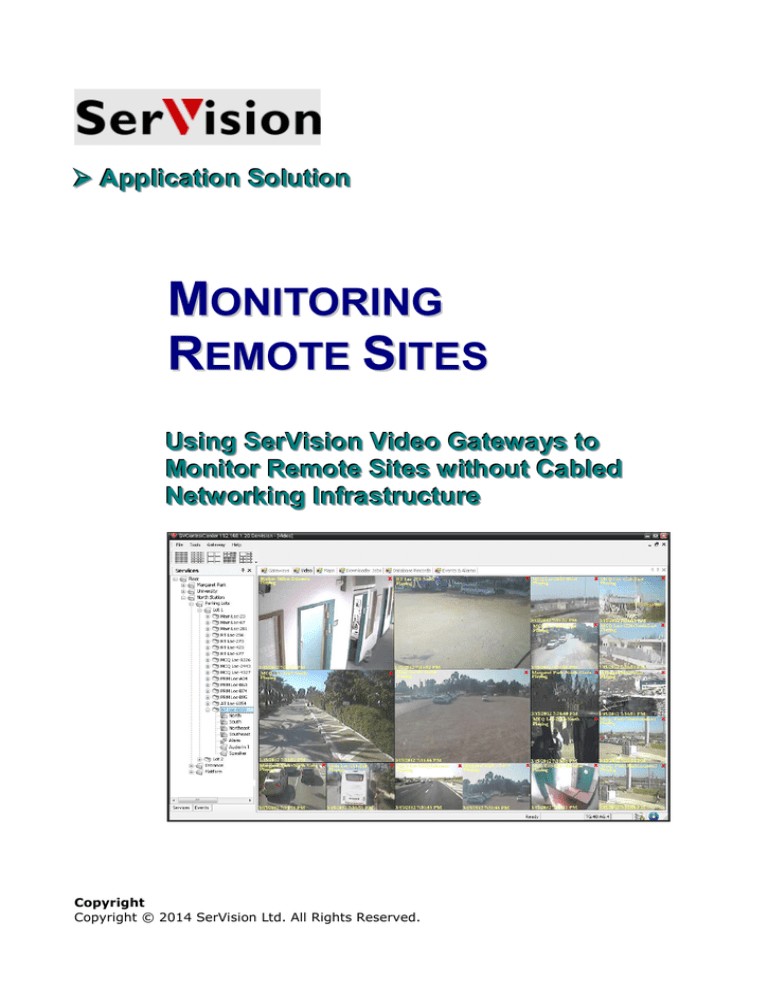
Application Solution
MONITORING
REMOTE SITES
Using SerVision Video Gateways to
Monitor Remote Sites without Cabled
Networking Infrastructure
Copyright
Copyright © 2014 SerVision Ltd. All Rights Reserved.
Application Solution
Overview
SerVision Video Gateways are powerful, multi-featured security systems that can stream highquality video to remote PCs and other devices over a variety of types of networks. They are
uniquely optimized for streaming data at exceptionally low bit rates, and are even capable of
transmitting video from sites where only GPRS coverage exists. The units can record video onsite, stream live or recorded video to remote users, monitor sensors, interface with GPS
tracking systems (MVG series only), and notify users instantly if events are detected.
This document explains how SerVision Video Gateways can be deployed at remote sites where
no cabled networking infrastructure is available. This solution can be successfully implemented
in a variety of settings, including parking lots, garages, construction sites, race tracks, train
yards, cellular base-stations, traffic junctions, and border fences. It also functions well in
portable security camera installations. For example, it can be set up in a trailer and rapidly
deployed at fairgrounds, roadside construction zones, and other temporary sites.
When this solution is implemented, video and other data is transmitted from the remote sites
via cellular and wireless networks to the internet. SerVision client applications, running on
PCs, smartphones, or tablets, can connect to the Video Gateways via the internet from
virtually any location to monitor the sites in real time. The Video Gateways on-site can be
powered by electricity when it is available or by heavy-duty batteries when it is not.
Video Gateway Models for Remote Sites
SerVision supplies three types of Video Gateways that are optimized for deployment in remote
stationary locations: the two-channel MVG200, the four-channel UVG400, and the SVG series
for up to sixteen channels. All models support transmission of video, audio, and other data
over cellular and WiFi networks, include built-in motion-detection and video-lost alarm
generators, and contain additional interfaces for connecting external sensors, switches, and
closed-circuit monitors. These interfaces make it possible, for example, to connect an alarm
that is activated when a gate is opened, or sensors that are activated when a border fence is
touched or cut. When these devices are activated, the unit can relay notifications to operators
monitoring the site, either through the client applications or via e-mail or SMS. In addition,
third party IP-based devices such as those dedicated to video analytics can connect to
available LAN ports on the UVG400 to share the unit’s cellular modem connection.
Client Applications for Monitoring the Video Gateway Units
SerVision offers two alternative monitoring solutions for PCs:
SVMultiClient: A PC-based monitoring system that uses the SVMultiClient client
application to interact directly with the Video Gateways in the field, this solution enables
users to monitor up to 70 Video Gateways, with minimal infrastructure. SVMultiClient
features a multi-stream video player, configurable alarms, downloading of recorded
video, and many other features. SVMultiClient is available free of charge to all SerVision
customers.
SerVision Ltd.
Monitoring Remote Sites
Page 1 of 10
Application Solution
Control Center setup using the SVMultiClient PC-based application for remote monitoring
SVControlCenter: A complete server-based monitoring system that is optimized for
large enterprises (up to 5,000 Video Gateways), SVControlCenter is a highly
customizable system featuring a multi-stream video player, configurable alarms, and an
alarm management system. In addition, a Downloader module enables automated
downloading of video to an internal database for long-term storage. SVControlCenter is
available for purchase from SerVision.
Control Center setup using the server-based SVControlCenter solution for remote monitoring.
Video Gateways can also be accessed remotely using a client application running on a
smartphone or tablet. SerVision client applications are available free of charge for iPhone,
iPad, Android, Windows Mobile, and Symbian devices. SerVision also provides a free SDK/API
that can be used to develop alternative client software or to integrate SerVision's protocol into
third party client software.
SerVision Ltd.
Monitoring Remote Sites
Page 2 of 10
Application Solution
Client devices using SVMultiClient or cellular clients to connect to Video Gateways through the internet
Setting Up the System
Setting up monitoring of a remote location entails a number of steps. To begin, you must
select the appropriate Video Gateway model(s) for the job and purchase the required
equipment. If you will be using cellular connections for the Video Gateways, you must arrange
to have a cellular uplink for each Video Gateway you will be using. Once you have done this,
you can install the Video Gateways and their peripheral equipment on site and ensure they are
connected to the internet. Finally, you must install the client applications on the PCs and other
devices you will use to monitor the Video Gateways. If you will be using SVControlCenter to
monitor the site, you will also have to purchase it and set it up in your control center.
This Document
The rest of this document provides additional information about setting up the remote-site
monitoring solution, including information about the various options available and the
resources each option requires.
Site Setup
Depending on the model of Video Gateway you choose, you can connect up to sixteen cameras
to each Video Gateway. In addition, you may want to connect other peripheral equipment,
such as sensors and activators, to the units. This equipment needs to be installed at the sites
you want to monitor. The required and optional equipment, as well as the 3G data plan
requirements, are explained in this section.
Before you can begin using the Video Gateways, they must be configured to ensure that they
function as required and can be accessed by client devices remotely. Instructions and support
for the configuration process are provided by SerVision.
SerVision Ltd.
Monitoring Remote Sites
Page 3 of 10
Application Solution
Required Equipment
The following equipment is required for each Video Gateway:
Hardware (including cables and antennas) supplied with the unit (supplied by SerVision)
3G USB cellular modem (appropriate GSM or CDMA modems can be supplied by
SerVision or provided by the local operator; a list of supported modems is available on
the SerVision website, http://www.servision.net)
SIM card for the cellular modem (for GSM networks; supplied by the customer)
Up to sixteen video cameras (supplied by SerVision or purchased separately)
Additional cabling for cameras, power, and other hardware, as required for installation
of all devices (supplied by the customer)
Optional Equipment
In addition to the required equipment, you may wish to use some or all of the following
optional equipment:
Dry-contact sensors
External sensor adapter (required if you are connecting dry-contact sensors to SVGseries Video Gateways; available for purchase from SerVision)
Activators (outputs devices like switches for activating other devices)
Microphones
External speaker (All Video Gateway units have built-in speakers.)
CCTV monitor
Switches for changing the CCTV display or the unit's settings
Additional storage media that have been approved by SerVision (hard-drives for
UVG400 and SVG units; microSD cards for MVG200 units)
Converter for connecting extra sensors and/or switches (ADAM module or IA relay
board)
DC-DC voltage stabilizer (for use with UVG400 units that use third-party power
supplies; if you do not use the power supply that is supplied with the unit, you must
purchase this stabilizer from SerVision)
Selecting a Video Gateway Model
You can choose any of the following models of Video Gateways to install at your site. If you
are using more that one Video Gateway, you do not have to use the same model in all
locations; choose the most appropriate model for each location.
UVG400
The UVG400 is optimized for deployment in remote stationary sites. It supports up to four
cameras and multiple sensor and activator connections, and has extensive video-recording
capacity. The standard UVG400 unit comes with a 250GB hard drive, which provides sufficient
storage capacity for recording four video channels continuously (24/7) at the default quality
setting (10FPS, 128kbps, SIF), for nearly 50 days of recorded video. The unit can be supplied
with a larger-capacity hard drive (up to 1 TB) upon request.
SerVision Ltd.
Monitoring Remote Sites
Page 4 of 10
Application Solution
MVG200
The MVG200 is ideal for smaller sites, both stationary and moving, for which only one or two
cameras, and minimal peripheral equipment, are required. The unit is supplied with a
removable 4GB microSD card that can store over two days of recorded video. MicroSD cards of
up to 64GB capacities can be used in the unit.
This model also contains a built-in GPS receiver, enabling operators to track its location using
SVMultiClient or SVControlCenter. This may be useful for units that are moved from one
location to another from time to time, as with units that are deployed in trailers and set up at
building sites.
SVG400 Series
The SVG400 series is suitable for larger sites that require up to sixteen cameras. Units are
available in four, eight, twelve, or sixteen channel models. All models are supplied with a
250GB hard drive, enabling continuous recording at the default recording settings (10FPS,
96kbps, SIF) for approximately 60, 30, 20, or 15 days, respectively. The units can be supplied
with larger-capacity hard drives (up to 2 TB) upon request. The four-channel SVG400-4 also
supports RAID for added data-storage security.
Choosing Cameras and Other Peripherals
Any analog video camera can be used with SerVision Video Gateways. SerVision supplies a
limited range of cameras with different features, but you can purchase cameras from other
sources if you wish. Since any analog camera is compatible with the Video Gateways, many
installers prefer to source cameras locally. This enables them to select a suitable model
camera that is fully compliant with the project specification and will meet the customer’s
expectations.
Video Gateways support a variety of other optional peripheral equipment, such as sensors,
switches, and CCTV monitors (see Optional Equipment, above). SerVision can supply some of
this equipment, but you must purchase other items on your own.
Calculating 3G Data-Consumption Requirements
The cellular line each Video Gateway uses to transmit video and other data to client devices
must have a data plan that is sufficient for the amount of traffic that will be handled by the 3G
cellular network. The required capacity varies depending on a range of factors: the number of
cameras in use, the quality of the video that will be transmitted, and how much video will be
transmitted. The requirements are highest if video from all cameras is continuously streamed
live at high quality to clients. You can reduce the requirements if you do not transmit data
continuously all day. For example, you could stream video from each Video Gateway briefly
from time to time to check on the site, and additionally when an alarm is set off, but avoid
streaming video for lengthy periods of time or downloading large amounts of recorded video
over the cellular line. As an alternative to downloading video, you could remove the storage
medium from the unit from time to time and replace it with an alternate. Then you could
transfer all of the recorded video you require by connecting the storage medium to your PC
directly.
Consider, for example, a Video Gateway that generates an average of ten daily events that
require real-time monitoring from a client device. For each such event, you can be expected to
view live video from two cameras for about five minutes each. In this scenario, the cellular line
is used for about 100 minutes (10 events x 5 minutes per event x 2 cameras) every day. If
each camera transmits video at 128 kilobits/second (kbps), the total amount of data
transmitted over a 30-day period via the 3G connection is about 2.88 GB (see calculation
below).
SerVision Ltd.
Monitoring Remote Sites
Page 5 of 10
Application Solution
To calculate your cellular data-consumption requirements for a Video Gateway, in GB, use the
following formula:
kilobits
bitrate
8 timeseconds number of cameras
seconds
1,000,000
For example, here is how you would calculate the data-consumption requirements for 50
minutes of video from two cameras transmitting at 128 kbps for 30 days:
128 kilobits 8 60sec 50min 30days 2cameras
sec
1,000,000
2.88GB
In real-world conditions, the live-stream bitrate of the Video Gateway will vary according to
network conditions (network signal strength, network traffic, etc). SerVision Video Gateways
are optimized to achieve the best streaming results given the network’s limitations. Even if the
Video Gateway is configured to transmit at a rate of 128 kbps, it is highly unlikely that the
data will actually be transmitted in a constant stream at this rate. In effect, this is the
maximum rate, and the actual rate will often be slower. The Video Gateway automatically
corrects for these fluctuations, transmitting stable video streams at a lower quality level – and
at speeds as slow as 5kbps – to match the available bandwidth and data rate, so the total data
consumption will likely be lower than the value that is derived using the formula.
In addition, even if you are recording in high resolution (SerVision Video Gateways support
both VGA and D1 resolutions), you do not necessarily have to transmit live video at the same
quality. By default, the Video Gateways support three standard video-quality settings for live
streaming in SIF resolution: High (128 kbps), Medium (96 kbps), and Low (36 kbps). Users
can also choose a different resolution or custom quality setting to suit the available bandwidth
or to control or minimize data consumption. Based on our experience, a 1-5GB monthly plan is
suitable for most project applications.
Client Setup
SerVision client applications, SVMultiClient and SVControlCenter, run on standard Windowsbased PCs and provide a full range of site-monitoring features. Regardless of which of these
clients you use, you must provide the PCs for them to run on.
In addition to the PCs and client applications, some projects may also require the following
systems:
SVProxy3 server: A system that facilitates network connections in certain environments
and expands video transmission capacities
SVMonitor system: An application that monitors the system for technical problems and
malfunctions affecting the Video Gateways. (This application is only required for small
projects that are using the SVMultiClient PC application for monitoring. The serverbased SVControlCenter solution has its own internal mechanism for monitoring Video
Gateway statistics.)
SVMultiClient-Based Site-Monitoring
Smaller operations can use the SVMultiClient client application for PCs to monitor their Video
Gateways. SVMultiClient can play live and recorded video and display notifications when
sensors are activated. It also allows you to remotely control PTZ cameras and devices that are
SerVision Ltd.
Monitoring Remote Sites
Page 6 of 10
Application Solution
connected to the system’s alarm outputs, to communicate with people on site, and to
download video to the PC. It is appropriate for use by individuals monitoring small sites in
which only one or two Video Gateways are installed, as well as by control centers with multiple
operators monitoring more extensive sites in which up to 70 Video Gateways are deployed.
Required Equipment
If you use SVMultiClient for monitoring your Video Gateways, you will need the following
equipment and infrastructure:
PCs for all operators (supplied by the customer; operators working different shifts can
share a single PC)
High-speed internet connection (supplied by the customer)
Optional Equipment
Control centers using SVMultiClient for vehicle monitoring may also require the following
equipment:
SVProxy3 server (supplied by SerVision; for additional information, see page 8)
Designated PC for SVMonitor application (supplied by the customer)
SVMonitor
Control-centers using SVMultiClient for vehicle monitoring may also choose to set up a
dedicated PC on which to run the SVMonitor application. This application helps control-center
operators monitor the Video Gateway units for technical problems that may require
maintenance, such as malfunctioning storage media, overheating of Video Gateway units, and
lost video connections. It automatically connects to each Video Gateway it monitors at
specified intervals and retrieves status information from it. If any of the information indicates
a possible problem, the system generates an alarm.
SVControlCenter-Based Control Centers
Larger-scale operations require the server-based SVControlCenter for Video Gateway
monitoring. SVControlCenter is an enterprise-level management and video-monitoring system
that can monitor up to 5,000 Video Gateway units. As its name implies, it is intended
exclusively for use in a control-center environment. The system's server retrieves data from
Video Gateways, stores it in an internal database, and manages the alarm and notification
system. Control-center operators receive information from the SVControlCenter servers via
SVControlCenter client applications. Each operator runs an SVControlCenter client application
on a PC workstation at the control center. Both the server and the operator workstations are
located at the control center and connected to the same LAN. The system can handle up to 20
SVControlCenter clients simultaneously.
All the SVControlCenter clients in the system are locally connected to the database server
whenever they are open, and the SVControlCenter server automatically relays event
information and alarm notifications to them. In addition, operators can connect directly from
the SVControlCenter client application to Video Gateways in order to view live video and to
play back recorded video that is stored on the Video Gateway.
SVControlCenter is supplied by SerVision as two separate industrial-strength servers that are
preloaded with all the required software: one server with Windows Server 2008 and the
SVControlCenter server application, and the other server with Windows Server 2008 and a
licensed copy of Microsoft's SQL server. When large numbers of Video Gateways are being
monitored, the system should be scaled to several computers to improve performance. All of
SerVision Ltd.
Monitoring Remote Sites
Page 7 of 10
Application Solution
the servers must be physically located in the control-center and connected to the same LAN as
the PC workstations that will be used by the control-center operators.
A Downloader module is available for use with SVControlCenter (see Transmitting Video over
an APN, page 9).
Required Equipment
Control centers using SVControlCenter for site monitoring require the following equipment:
SVControlCenter server (supplied by SerVision)
MS SQL server (supplied by SerVision, or supplied by the customer if only the
SVControlCenter license is purchased)
PCs for each operator (supplied by the customer; operators working different shifts can
share a single PC)
A high-speed internet connection (supplied by the customer)
SVProxy3 server (optional, as explained below; supplied by SerVision)
Redundanc y Solutions
To ensure system stability in case of equipment failures, key system functions and data can be
duplicated. Redundancy solutions such as failover clustering, database mirroring, and
database mirroring using a witness server, can all be implemented. Consultation with a
SerVision support engineer is recommended.
SVProxy3
In addition to the PCs, you may require an SVProxy3 server. SVProxy3 provides a number of
services:
Proxy service (SVProxy): This service facilitates connections between client
applications and Video Gateways that do not have public IP addresses. The proxy server
is required in the event that the local cellular provider is not able to assign a public IP
address to its cellular lines.
Video-Distribution service (SVDistributor): This service distributes a single live
video stream from a Video Gateway to multiple clients simultaneously without
compromising the quality of the image. This is helpful if many control-room operators
need to access images from the same camera simultaneously.
Dynamic DNS (SVDDNS): This service can be used to assign a name to a Video
Gateway, whether it has a fixed public IP address or not.
If your cellular lines all have public fixed IP addresses or connect to a VPN with a fixed IP
address, the SVProxy3 server is not necessary. In these cases, the other services are not
required for successful operation of the control center either.
Both the hardware and software of SVProxy3 are supplied by SerVision. One SVProxy3 server
can support connectivity for up to 300 Video Gateway units.
SerVision Ltd.
Monitoring Remote Sites
Page 8 of 10
Application Solution
SVProxy3 deployed in a control center
Control-Center Bandwidth Requirements
If you are managing a large number of Video Gateways from a control center, you must
ensure the control center has an internet connection that has enough bandwidth and is fast
enough to allow operators to view video as required. Video and other data is relayed from
Video Gateways over the cellular network to the internet, and is transmitted over the internet
to the control center.
To calculate the required Control-Center’s bandwidth and modem speed, determine the
maximum number of video streams that will be opened by the control center simultaneously,
and then multiply this number by the maximum transmission bitrate of each video stream. If,
for example, the control center will have four PCs, and each one will have at most eight video
streams open at one time, at a maximum bitrate of 128 kbps per stream, the required
network capacity would be about four Mbps ( 128kbps 8streams 4clients 4,096kbps 4Mbps ).
This calculation should be viewed as the absolute minimum bandwidth requirement. It is
highly recommended to get a more robust internet connection than the initial calculation
suggests you need, especially if you will also be downloading recorded video, or other devices
are also connecting to the internet over the same connection. For most projects, we
recommend a download capacity of at least 10 Mbps.
Transmitting Video over an APN
The most common way for client devices to connect to Video Gateways that are situated in
remote locations is via the cellular network. A standard cellular uplink works well if you only
need to view video for short periods of time. If you want to stream live video for extended
periods of time, or download a large volume of recorded video over each Video Gateway’s
cellular uplink, it may be more cost-effective to set up a private cellular APN that is dedicated
for use exclusively among the IP addresses that have been assigned to the SIM of each Video
Gateway. A private APN can be set up for you by your cellular operator, and can handle high
volumes of traffic for a sustained period of time.
SerVision Ltd.
Monitoring Remote Sites
Page 9 of 10
Application Solution
Required APN Capacity
Before you arrange for an APN, you should calculate the data capacity required, and confirm
the speed of the network, so that you can purchase an appropriate data package from your
cellular operator. You can calculate your requirements using the formula given on page 6.
Downloading Recorded Video
Once you have an APN set up, it may be possible to download recorded video from your Video
Gateways for long-term storage. Both SVMultiClient and SVControlCenter can download video
to the PCs on which they are running. SVControlCenter can also download video to the
SVControlCenter database, and can be configured to automatically capture and store live video
streams upon sensor trigger.
SVControlCenter’s Downloader module can be configured to download video to the
SVControlCenter database during specified times. All locally recorded video stored on the
Video Gateway’s disk or micro SD card can be downloaded to the database (provided that your
APN is robust enough to handle this), or you can opt to only download video of events that
were detected by sensors.
Downloading data via APN to the SVControlCenter database
SerVision Ltd.
Monitoring Remote Sites
Page 10 of 10



